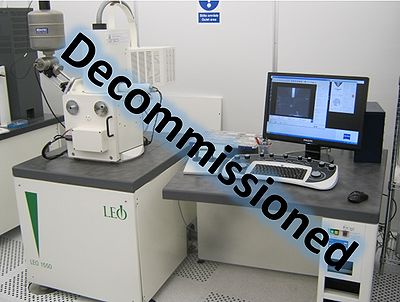Specific Process Knowledge/Characterization/SEM LEO: Difference between revisions
| Line 5: | Line 5: | ||
=SEM LEO= | =SEM LEO= | ||
[[image:IMG_3290.jpg|400x400px|right|thumb| | [[image:IMG_3290.jpg|400x400px|right|thumb|The SEM LEO]] | ||
A Danchip there are four scanning electron microscopes (SEMs). These SEMs cover a wide range of needs both in the cleanroom and outside: From the fast in-process verification of different process parameters such as etch rates, step coverages or lift-off quality to the ultra high resolution images on any type of sample intended for publication. | A Danchip there are four scanning electron microscopes (SEMs). These SEMs cover a wide range of needs both in the cleanroom and outside: From the fast in-process verification of different process parameters such as etch rates, step coverages or lift-off quality to the ultra high resolution images on any type of sample intended for publication. | ||
Revision as of 14:43, 27 April 2016
THIS PAGE IS UNDER CONSTRUCTION
Feedback to this page: click here
SEM LEO

A Danchip there are four scanning electron microscopes (SEMs). These SEMs cover a wide range of needs both in the cleanroom and outside: From the fast in-process verification of different process parameters such as etch rates, step coverages or lift-off quality to the ultra high resolution images on any type of sample intended for publication.
All SEMs are operated by use of the same software, hardpanel and joystick. But there are small hardware differences, thus a training is needed for each SEM you want to use.
The SEM LEO was installed in the cleanroom in the 1998, and the software was ungraded in 2012.
This SEM will cover most users need. It is a very reliable and rugged instrument that provides high quality images of most samples. Excellent images on a large variety of materials such as semiconductors, semiconductor oxides or nitrides, metals, thin films and some polymers may be acquired on the SEM.
The SEM LEO is good, reliable, the software is basically indentical to the SEM Zeiss software, and for conducting samples (or thin layers, < 5-10 µm, of hard non-conducting materials such as oxide/nitride on top a conducting substrate) the resolution of the SEM LEO is almost comparable to the both the SEM 1, SEM 2 and SEM 3 Supra 60VP.
The SEM is is equipped with a Raith e-beam writing system.
The user manual, control instruction, the user APV and contact information can be found in LabManager:
SEM LEO info page in LabManager,
Performance information
Link til Raith information
| Equipment | SEM LEO (Leo 1550 SEM) | |
|---|---|---|
| Purpose | Imaging and measurement of |
|
| Location |
| |
| Performance | Resolution |
The resolution is strongly dependent on the type of sample and the skills of the operator. |
| Instrument specifics | Detectors |
|
| Stage |
| |
| Electron source |
| |
| Operating pressures |
| |
| Options |
| |
| Substrates | Batch size |
|
| Allowed materials |
Use dedicated samples holders for samples from Black Magic PECVD | |
